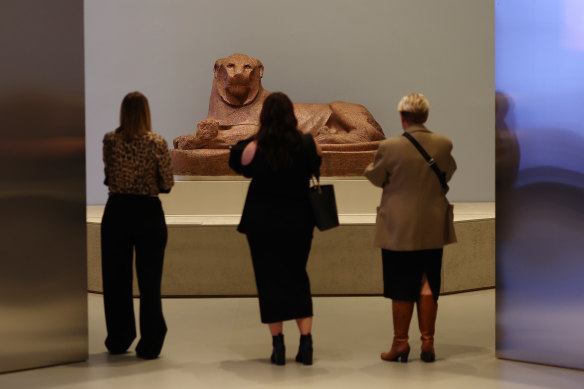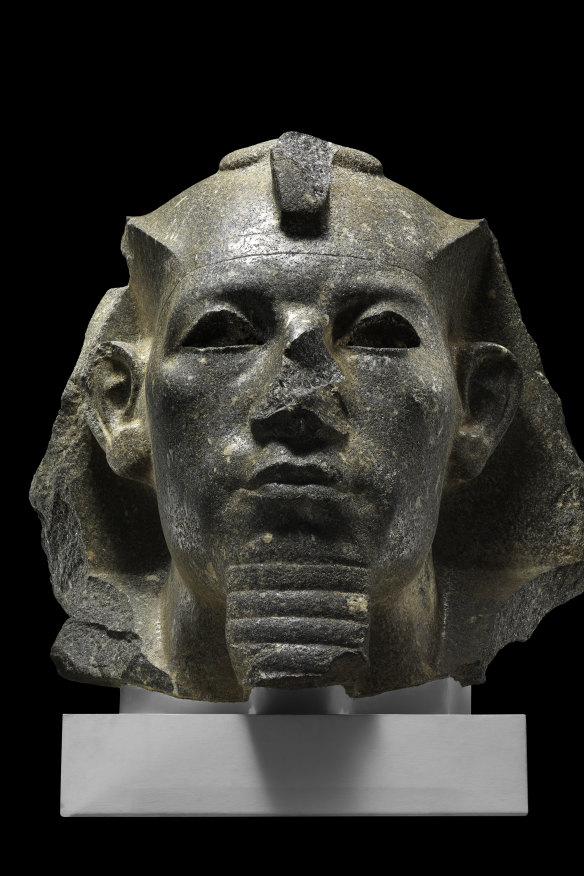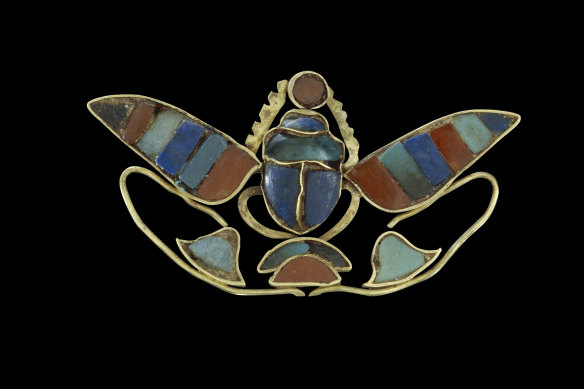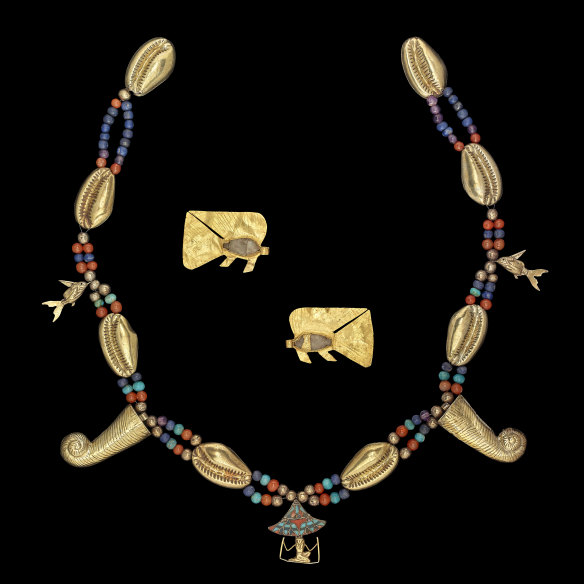This was published 1 year ago
This is a monumental exhibition worthy of its monumental subject
Pharaoh – the British Museum’s largest-ever loan exhibition – is quite exceptional.

Visitors view the Melbourne Winter Masterpieces exhibition Pharoah at NGV International.Credit: Getty Images for the NGV
Until the Eiffel Tower came along in 1889, the Great Pyramid of Giza, built by the Pharaoh Khufu (c.2600 BCE), was the tallest building on earth. Not many world records have stood for 4000 years, and no great civilisation lasted so long as pharaonic Egypt. It began with the reign of Narmer (c. 3000 BCE), the first ruler to unify the upper and lower halves of the country, and finished with Cleopatra (51–30 BCE), a legendary figure of the ancient world.
I know some will argue there have been 65,000 years of Aboriginal civilisation or even 5000 years of the Chinese variety, but there is no credible comparison. What makes Ancient Egypt unique is the power and longevity of the pharaonic system, which withstood multiple invasions, occupations, uprisings and rebellions, transforming every antagonist into another version of itself.
Even Alexander the Great, who conquered Egypt in 332 BCE, would fall under its spell. The young Macedonian strongman paid homage to the country’s gods and shrines and was regularly depicted in the traditional costume of an Egyptian ruler. In Pharaoh, at the National Gallery of Victoria, there’s a sandstone tablet showing an Egyptianised Alexander worshipping a sacred bull.

A gigantic head presumed to be that of the Egyptian Pharoah Amenemhat III, who reigned in the 12th dynasty.Credit: © The Trustees of the British Museum
By now, we should be accustomed to the commitment the NGV brings to bear with every major show, but Pharaoh – the British Museum’s largest-ever loan exhibition – is quite exceptional. A monumental subject has brought forth a monumental feat of exhibition design. There are more than 500 items on display, but the hang feels remarkably spacious, accommodating massive stone statues and tiny pieces of jewellery so the viewer alternates between feelings of awe and intimacy.
NGV designer Peter King has conceived the exhibition as a journey from dawn to night. The lighting, wall textures and colours are subtly calibrated to match this conceit as we travel from darkness to light and back again. Between galleries, we walk down long, dark corridors towards an illuminated portal as if we were entering or leaving a tomb.
One of the most breathtaking galleries is the colour of a swimming pool, complete with aqueous flickers on the walls, reflected from a series of shiny, wavy columns. It’s only when we begin to explore that we realise each column is also a vitrine laden with jewellery.
Another surprise is an original soundtrack by Peter Corrigan that lends an Egyptian ambience to the visit. This touch could easily have gone wrong, but the composer has handled the task with great skill, creating music that is atmospheric but never intrusive.

Ornament of a winged scarab holding a sun disc.Credit: © The Trustees of the British Museum
The exhibition has been selected by Marie Vandenbeusch, the BM’s Curator: Funerary Culture of the Nile Valley, in consultation with her NGV counterparts. She took her lead from an earlier travelling exhibition of the same name that toured Spain. That small-scale show has grown into a far more comprehensive display, using the pharaoh as the central organising principle. It’s an uncontroversial idea because the history of Ancient Egypt is organised in terms of dynasties, the reigns of the rulers and their families.
There are seven sections covering everything from the pharaohs’ relationship to the gods to family life, foreign affairs, the administration of Egypt, and the royal tombs. The aim is to cover 3000 years of history through artefacts, works of art, and crafts. There are no mummies in this show, although there is a stunning sarcophagus. The highlights are the stone sculptures and small, exquisite pieces of jewellery, every item invested with meaning.

A 12th-dynasty girdle with gold amulets, beads and pendants comprising electrum, silver, lapis lazuli, feldspar, amethyst, cornelian and glass.Credit: © The Trustees of the British Museum
In the first room, one is greeted by a colossal head of Amenemhat III (c. 1854–08 BCE), once part of a full figure but now isolated on a mirrored column. The effect is both awesome and elegiac. We feel the power of this long-dead ruler, even if today he is no more than a disembodied head. Looking at the column, we see ourselves. It hints at the way the pharaoh’s exalted status was built on the labour and reverence of ordinary people.
Another finely carved bust in the same room is the image that appears on the cover of the catalogue: a head of Thutmose III (1479-25), wearing a distinctive bulb-shaped crown with a rearing cobra. The king is depicted with a gentle smile and alert, almond-shaped eyes, yet there is no way of knowing if any portrait bust bore much physical resemblance to its royal subject. It was all propaganda, albeit of high artistic quality. A king might choose to look wise or stern, a pair of overly large ears could mean he is listening to his people.
One convention that lasted throughout the entire pharaonic period was the depiction of the ruler as a giant towering over commoners and usually smiting his enemies. (It’s a motif Albo might consider). This is the way the king appears in the Narmer Palette, a seminal stone carving from the first dynasty (c. 3000 BCE). The original is on permanent display in Cairo, but the BM has included an exact cast.

Figures of a king and two gods in jubilation.Credit: © The Trustees of the British Museum
The palette, which shows Narmer preparing to bludgeon an enemy with a club, is an explicit threat to all challengers. The pharaoh had unified Egypt by force of arms and would hold on to his throne in the same way. The pattern would be repeated with almost every one of the more than 170 pharaohs that followed. They fought to extend Egypt’s sphere of influence or defend its boundaries against a succession of invaders. In time the barbarians – Hyksos, Libyans, Nubians, Assyrians - would win those battles and install themselves as Pharaohs. The kings of the Ptolemaic period were Greek speakers who adopted the outward forms of Egyptian kingship.
No matter where a pharaoh may have originated, for 3,000 years, they wielded absolute power over everyone and everything, allowing the machinery of government to be run by an army of bureaucrats. During days of prosperity, the arts and civic works flourished, but in lean times, the kings would cannibalise their predecessors’ monuments for their own purposes. The greatest tomb robbers were the pharaohs of later dynasties who plundered the graves of the most celebrated pharaohs to make up for their own relative poverty.

A limestone ostracon (fragment containing an inscription) depicts the workman Khnummose adoring the snake goddess Meresger. The writing on the other side mentions his two sons.Credit: © The Trustees of the British Museum
It’s an accident of fate that a minor figure, such as Tutankhamun, is now the best-known pharaoh of all time, having made it through to 1922 with his tomb largely intact. His more illustrious peers, such as Ramses II, Amenhotep III and Thutmose III, did not have his posthumous luck. The rebel Pharaoh Akhenaten, who sought to do away with the pantheon of Egyptian gods in favour of a single deity, was almost obliterated from the records after his death. If any of these kings’ tombs had survived, they would have presented a spectacle beyond Hollywood’s imaginings.
With so many items in this show, I can only hope to talk about a fraction of them. The most striking pieces, such as 10 tall statues of the lion-headed goddess, Sekhmet, speak for themselves, while many small gold objects repay the closest scrutiny. If there’s an indisputable masterpiece, it must be the seated statue of Sety II (1200–1194 BCE), which is so elegant and so beautifully carved the sculptor would be acclaimed as a master if only we knew his name.
One small but extraordinary piece is a miraculously preserved sheet of papyrus that shows Nestanebetisheru, a priest’s daughter, communing with the falcon-headed god Ra-Horakhty. The work dates from c. 950–930 BCE, but it’s fresher than most of the paperbacks mouldering away on our bookshelves. A crisp line drawing with figures in characteristic silhouettes, it’s mind-boggling to think this image puts us in close contact with a young Egyptian woman who died almost 3000 years ago.
There is at least one work that manages to combine the symbolism of power with a sense of human intimacy – a limestone statue of Horemheb and his wife (c. 1336–23 BCE), which depicts the couple dressed in their best Issey Miyake pleats, sitting placidly, as if posing for the camera. Horemheb, a fearsome general and ruthless politician, was Tutankhamun’s likely successor, but his ascension to the throne was held up because he was away on a campaign when the king died, and the crown was grabbed by the elderly vizier, Ay. When Ay expired four years later, Horemheb was quick to seize power and, by way of revenge, destroy his predecessor’s tomb.
In the sculpture, this fearsome warrior is resting his hand in his wife’s lap, where she takes it gently between her own hands – or would be doing so if someone hadn’t smashed that part. A power couple at court, Horemheb and his spouse look as harmless as a pair of small children on their best behaviour. One wonders if those touching hands enraged the unknown iconoclast who attacked the work. After all these years, they still look like a couple in love.
Pharaoh is at the National Gallery of Victoria, Melbourne, until October 6.